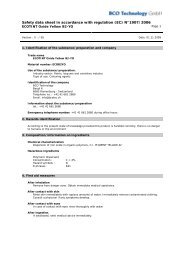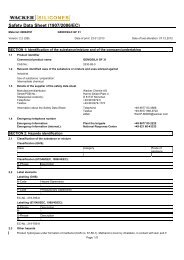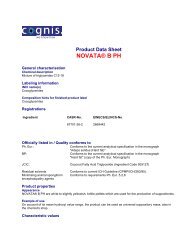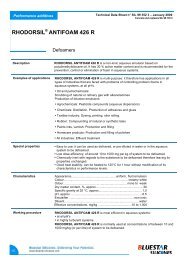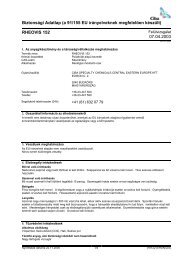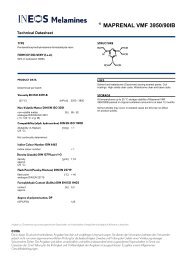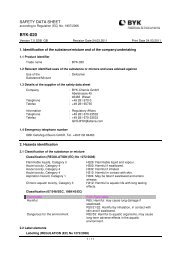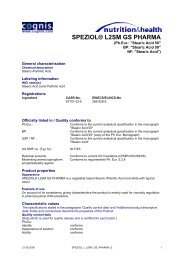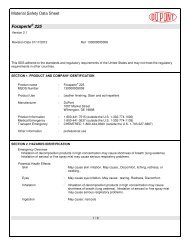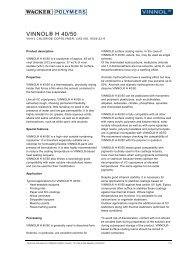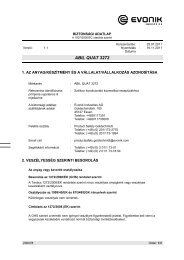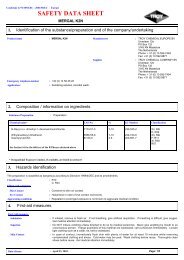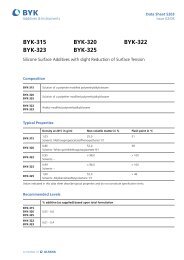THERMOLITE (R) 190
THERMOLITE (R) 190
THERMOLITE (R) 190
You also want an ePaper? Increase the reach of your titles
YUMPU automatically turns print PDFs into web optimized ePapers that Google loves.
<strong>THERMOLITE</strong> (R) <strong>190</strong>Material Safety Data SheetArkema Inc.1PRODUCT AND COMPANY IDENTIFICATIONAdditives2000 Market Street28th FloorPhiladelphia, PA 19103-3222Information Telephone NumbersCustomer ServiceEMERGENCY PHONE NUMBERS:Chemtrec: (800) 424-9300 (24hrs) or (703) 527-3887Medical: Rocky Mountain Poison Control Center(866) 767-5089 (24Hrs)Phone Number800.446.2800Available Hrs8:00 AM - 5:00 PMProduct NameProduct Synonym(s)Chemical FamilyChemical FormulaChemical NameEPA Reg NumProduct Use<strong>THERMOLITE</strong> (R) <strong>190</strong>Organotin MixtureNANANEStabilizer2 COMPOSITION / INFORMATION ON INGREDIENTSIngredient Name CAS RegistryNumber Typical Wt. % OSHAOrganotin mercaptideOrganotin mercaptideMercaptanThe substance(s) marked with a "Y" in the OSHA column, are identified as hazardous chemicals according to thecriteria of the OSHA Hazard Communication Standard (29 CFR 1910.1200)The components of this product are all on the TSCA Inventory list.ProprietaryProprietaryProprietaryThis material is classified as hazardous under Federal OSHA regulation.71-7622-271-3YYY3 HAZARDS IDENTIFICATIONEmergency OverviewClear liquid with a slight mercaptan odor.WARNING!MAY CAUSE ALLERGIC SKIN REACTION.MAY BE HARMFUL IF SWALLOWED.MAY CAUSE SKIN IRRITATION.Potential Health EffectsInhalation and skin contact are expected to be the primary routes of occupational exposure to this material. Based onits composition, it is anticipated to be slightly toxic if swallowed or absorbed through skin, practically non-toxic if inhaled,slightly irritating to skin and practically non-irritating to eyes. Repeated or prolonged contact may cause an allergic skinreaction. High vapor concentrations may be irritating to the eyes and respiratory tract, and may result in centralnervous system (CNS) effects such as headache, dizziness, nausea, drowsiness and, in severe exposures, loss ofProduct Code: RSO00 Revision: 13 Issued: 19 OCT 2004Page 1 of 6
consciousness.<strong>THERMOLITE</strong> (R) <strong>190</strong>Material Safety Data SheetArkema Inc.4 FIRST AID MEASURESIF IN EYES, immediately flush with plenty of water.IF ON SKIN, immediately wash with soap and plenty of water. Remove contaminated clothing and shoes.Get medical attention if symptoms occur. Wash clothing before reuse. Thoroughly clean shoes before reuse.IF SWALLOWED, induce vomiting immediately as directed by medical personnel. Get medical attention.NEVER GIVE ANYTHING BY MOUTH TO AN UNCONSCIOUS PERSON.IF INHALED, remove to fresh air.5 FIRE FIGHTING MEASURESFire and Explosive PropertiesAuto-Ignition TemperatureFlash PointFlammable Limits- UpperLowerNENENENEFlash Point MethodExtinguishing MediaUse water spray, carbon dioxide, foam or dry chemical.Fire Fighting InstructionsFire fighters and others who may be exposed to products of combustion should wear full fire fighting turn outgear (full Bunker Gear) and self-contained breathing apparatus (pressure demand NIOSH approved orequivalent). Fire fighting equipment should be thoroughly decontaminated after use.Fire and Explosion HazardsWhen burned, the following hazardous products of combustion can occur:Oxides of carbonTin oxides6ACCIDENTAL RELEASE MEASURESIn Case of Spill or LeakIsolate hazard area and deny entry to unnecessary or unprotected personnel. Contain spilled liquid withsand or earth. Clean up spill immediately, observing precautions in the Personal Protection section ofMSDS. Avoid runoff into storm sewers and ditches which lead to waterways.7HANDLING AND STORAGEHandlingAvoid prolonged or repeated contact with skin. Wash thoroughly after handling. Use only with adequateventilation.Product Code: RSO00 Revision: 13 Issued: 19 OCT 2004Page 2 of 6
<strong>THERMOLITE</strong> (R) <strong>190</strong>Material Safety Data SheetArkema Inc.7HANDLING AND STORAGEStorageStore in a cool, dry place. Keep away from heat, sparks and flame. Keep containers tightly closed. Do NOTstore near strong acids. Material can burn; limit indoor storage to areas equipped with appropriate automaticsprinkler system.8EXPOSURE CONTROLS / PERSONAL PROTECTIONEngineering ControlsInvestigate engineering techniques to reduce exposures below airborne exposure limits. Provide ventilationif necessary to control exposure levels below airborne exposure limits (see below). If practical, use localmechanical exhaust ventilation at sources of air contamination such as open process equipment.Eye / Face ProtectionWhere there is potential for eye contact, wear chemical goggles and have eye flushing equipment available.Skin ProtectionWear appropriate chemical resistant protective clothing and chemical resistant gloves to prevent skincontact. Consult glove manufacturer to determine appropriate type glove material for given application.Wear face shield and chemical resistant clothing such as a rubber apron when splashing may occur. Rinsecontaminated skin promptly. Wash contaminated clothing and clean protective equipment before reuse.Wash skin thoroughly after handling.Respiratory ProtectionAvoid breathing vapor or mist. When airborne exposure limits are exceeded (see below), use NIOSHapproved respiratory protection equipment appropriate to the material and/or its components. Consultrespirator manufacturer to determine appropriate type equipment for given application. Observe respiratoruse limitations specified by NIOSH or the manufacturer. For emergency and other conditions whereexposure limit may be significantly exceeded, use an approved full face positive-pressure, self-containedbreathing apparatus or positive-pressure airline with auxiliary self-contained air supply. Respiratoryprotection programs must comply with 29 CFR § 1910.134.Airborne Exposure Guidelines for IngredientsExposure LimitOrganotin mercaptideACGIH Skin designatorACGIH STELACGIH TWAOSHA TWA PELOrganotin mercaptideACGIH Skin designatorACGIH STELACGIH TWAOSHA TWA PEL--------ValueY0.2 mg/m30.1 mg/m30.1 mg/m3Y0.2 mg/m30.1 mg/m30.1 mg/m3-Only those components with exposure limits are printed in this section.-Skin contact limits designated with a "Y" above have skin contact effect. Air sampling alone is insufficient to accurately quantitateexposure. Measures to prevent significant cutaneous absorption may be required.-ACGIH Sensitizer designator with a value of "Y" above means that exposure to this material may cause allergic reactions.-WEEL-AIHA Sensitizer designator with a value of "Y" above means that exposure to this material may cause allergic skin reactions.Product Code: RSO00 Revision: 13 Issued: 19 OCT 2004Page 3 of 6
<strong>THERMOLITE</strong> (R) <strong>190</strong>Material Safety Data SheetArkema Inc.9 PHYSICAL AND CHEMICAL PROPERTIESAppearance/OdorpHSpecific GravityVapor PressureVapor DensityMelting PointFreezing PointBoiling PointSolubility In WaterClear liquid with a slight mercaptan odor.NENENENENENENEInsoluble10 STABILITY AND REACTIVITYStabilityThis material is chemically stable under normal and anticipated storage and handling conditions.Hazardous PolymerizationDoes not occur.IncompatibilityAvoid contact with acids.Hazardous Decomposition ProductsUpon thermal decomposition, the following products may be produced:Oxides of CarbonTin Oxides11 TOXICOLOGICAL INFORMATIONToxicological InformationData on this material and/or its components are summarized below.Organotin MixtureSingle exposure (acute) studies indicate that this material is slightly toxic to rats if swallowed (LD50 1,100-1,840mg/kg) and rabbits if absorbed through skin (LD50 1,000-2,150 mg/kg), practically non-toxic to rats if inhaled (1-hr LC50 240 mg/l), slightly irritating to rabbit skin (2.6/8.0, 24-hr exposure) and practically non-irritating to rabbiteyes.No skin allergy was observed in guinea pigs following repeated exposure. Repeated administration in the dietof rats produced pathological changes in the kidneys. Long-term administration in the diet of rats produced noadverse effects and no tumors were observed. No effects were seen on the ability of male or female rats toreproduce following administration in the diet for 2 successive generations. This material produced no geneticchanges in standard tests using bacterial cells.MercaptanSingle exposure (acute) studies indicate that this material is moderately toxic if swallowed (rat LD50 303 mg/kg),no more than slightly toxic if absorbed through skin (rat LD50 >2,000 mg/kg) or inhaled (rat 6-hr LC0 0.51 mg/l),non-irritating to rabbit eyes and slightly irritating to rabbit skin.Product Code: RSO00 Revision: 13 Issued: 19 OCT 2004Page 4 of 6
<strong>THERMOLITE</strong> (R) <strong>190</strong>Material Safety Data SheetArkema Inc.11TOXICOLOGICAL INFORMATIONExposure of workers resulted in headaches, dizziness, fatigue, weariness and gastrointestinal symptoms. Skinallergy was observed in guinea pigs following repeated exposure. An increase in mortality was noted in ratsfollowing short-term oral exposure (NOEL 150 mg/kg) and in rats and guinea pigs following repeated dermalapplication. Slight liver, kidney and blood effects were noted in one study following repeated dietaryadministration to rats. Generally, no genetic changes were observed in tests using bacteria, animal cells oranimals.12ECOLOGICAL INFORMATIONEcotoxicological InformationData on this material and/or its components are summarized below.Organotin MixtureThis material is practically non-toxic to algae (96-hr EC50 260 mg/l), mysid shrimp (96-hr LC50 170 mg/l) andfathead and sheepshead minnows (96-hr LC50 >1,000 mg/l). It is slightly toxic to Daphnia magna (48-hr EC5032 mg/l).Chemical Fate InformationNo data are available.13 DISPOSAL CONSIDERATIONSWaste DisposalIncineration is the recommended method for disposal observing all local, state and federal regulations.14 TRANSPORT INFORMATIONDOT NameDOT Technical NameDOT Hazard ClassUN NumberDOT Packing GroupRQNot Regulated by DOT.PG15 REGULATORY INFORMATIONHazard Categories Under Criteria of SARA Title III Rules (40 CFR Part 370)Immediate (Acute) Health Y FireNDelayed (Chronic) Health N ReactiveNSudden Release of Pressure NThe components of this product are all on the TSCA Inventory list.Ingredient Related Regulatory Information:Product Code: RSO00 Revision: 13 Issued: 19 OCT 2004Page 5 of 6
SARA Reportable QuantitiesMercaptanOrganotin mercaptideOrganotin mercaptide<strong>THERMOLITE</strong> (R) <strong>190</strong>Material Safety Data SheetArkema Inc.CERCLA RQNENENESARA TPQNew Jersey Right to KnowThis product does contain the following chemical(s), as indicated below, currently on the New Jersey Right-to-Know Substances List.Organotin mercaptideOrganotin mercaptide16 OTHER INFORMATIONRevision InformationRevision Date19 OCT 2004Revision Number 13Supercedes Revision DatedRevision Summary11-OCT-2004ATOFINA Chemicals, Inc. has changed its name to Arkema Inc.KeyNE= Not Established NA= Not Applicable (R) = Registered Trademark<strong>THERMOLITE</strong> is a registered trademark of Arkema Inc.Arkema Inc. believes that the information and recommendations contained herein (including data andstatements) are accurate as of the date hereof. NO WARRANTY OF FITNESS FOR ANY PARTICULARPURPOSE, WARRANTY OF MERCHANTABILITY, OR ANY OTHER WARRANTY, EXPRESSED ORIMPLIED, IS MADE CONCERNING THE INFORMATION PROVIDED HEREIN. The information providedherein relates only to the specific product designated and may not be valid where such product is used incombination with any other materials or in any process. Further, since the conditions and methods of use arebeyond the control of Arkema Inc., Arkema Inc. expressly disclaims any and all liability as to any resultsobtained or arising from any use of the product or reliance on such information.Product Code: RSO00 Revision: 13 Issued: 19 OCT 2004Page 6 of 6



